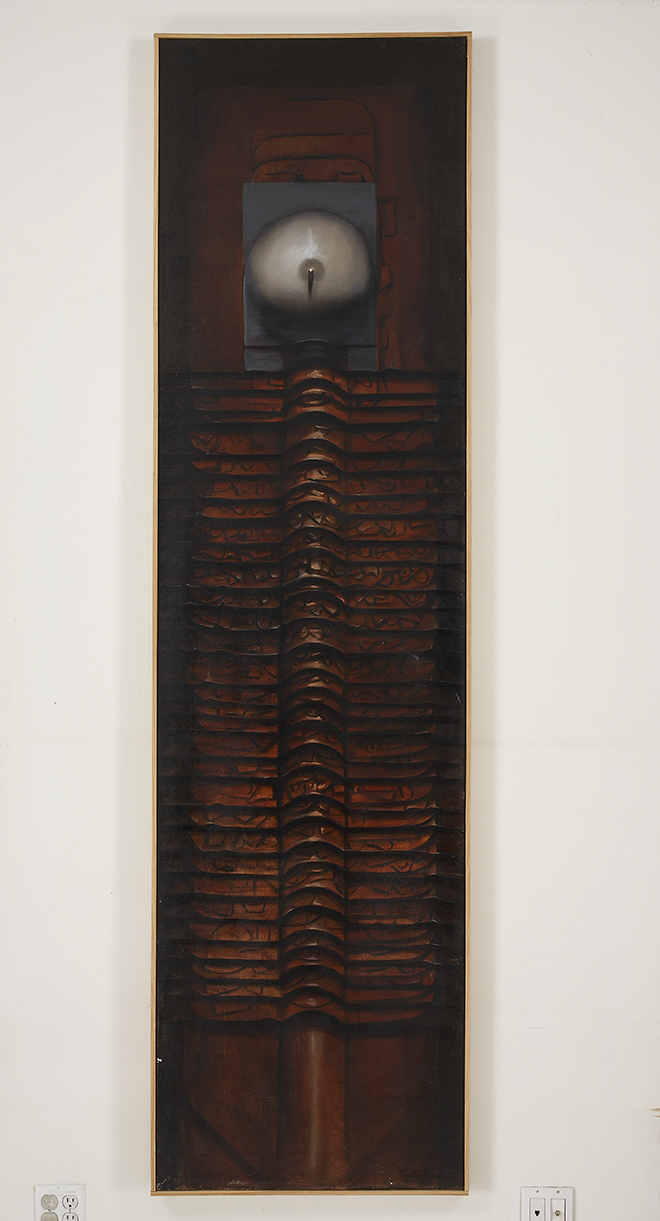Ana Castillo's Give It To Me 2014's Literary Sensation Michael Sedano
Review: Ana Castillo.
Give It To Me. NY: The Feminist Press, 2014.
ISBN: 9781558618503
The literary sensation of 2014 is Ana Castillo’s
Give It To Me. Castillo’s written no flash-in-the-pan-let’s-churn-out-a-series sensation.
Castillo’s outrageous storytelling creativity will have readers passing copies to all their friends, who will already have their own copy.
Give It To Me is sure to engage many a graduate seminar, moving the novel toward the top of all United States novels for its character, Palma Piedras, the novel’s narrative voice, its satire of eroticism, and overall richness.
Ana Castillo sends a woman on a sexual odyssey that samples incest, orgy, rape, cougarhood. Palma Piedras is bi- though mostly prefers women. Palma repeatedly takes on random partners, men, women, gay, straight, singly and in pairs. Rather than move with deliberation, Palma is often simply in the way of other people’s passions. At 43 years old, Palma Piedras is at the nadir of a life in shambles in the wake of death, divorce, and hysterectomy.
Unabashedly sexual without being erotic, Ana Castillo introduces a new ethos to her cast of women. Highly competent as a book translator, emotionally directionless, Palma is neither strong nor in control of much more than where she sleeps. “Anything goes, why not?” would be Palma’s motto if she had one. If Palma has a motive or philosophy, the narrator keeps it well under cover, snarking out Palma’s views on men and sex.
Machismo is lonely, keep the front up, never let anyone in. Palma doesn’t object that a macho perceives himself at war with the world, she’s at war, too. Men are “sex, food, and leave me alone for the rest of my life.” Sex is teatro, performance. The act gets old soon enough, else people get "laid to waste." Women make emotional contact leading to an intimacy that replaces passionate sexual athleticism of early dates.
Palma Piedras is a normal woman with a freaky side that takes over Palma’s vulnerable moments, or asserts itself seemingly at random, in guise of something Palma wants to do. Palma and her enamorado, Pepito, go through a series of misadventures dating back to when he was fourteen and Palma left Abuela’s house and her lil cous’. Pepito focuses Palmas awareness--he is unfinished business, otherwise she’s careening from this to that.
Palma and Ursula split up. Pepito comes to town. Gay friend Randall and Palma prove that each has equipment the other needs. Palma gives it to some gardener by sunbathing nude while he trims the bushes. Pepito takes an intimate cellcam foto and promises to sell it, later sends her cash. Don Ed comes to town and Palma’s his sure thing blind date. Palma is arrested for lewd public display next to Abuela’s grave. Palma hooks up with a 25-year old Apple genius and poet who thumps her against the wall to a rap beat. Palma is having second thoughts about being on the bottom with Austin on her and Mischa on top of Austin, when the hotel maid walks in. Palma gets naked and alluring, Pepito keeps his clothes on then walks out.
Those are the misadventures just of Part I. The novel is put together in three parts. In Part II, Palma is raped and exacts revenge on the woman. Palma meets her birth mother and unknown father in Los Angeles. The man looks Palma up and down and licks his lips, he’d take it from her.
Abandoned by the mother and raised by a resentful abusive abuela, Palma has invested longing that her mother will be the opposite of abuela and welcome the long-lost abandoned child. Mom can’t wait for the stranger to leave town. She has a replacement family.
Castillo draws an interesting parallel between Palma’s love life and family ties. Once the passion fades, emotional intimacy defines the value of relationships. Palma’s mother long lost passion borne of guilt. Mom’s world is so distant that there’s no absence to fill with emotional connection. Palma knows she can move on from a lover. How can she go home again when there was never a home?
Part III sees Palma and Venus break it off. Venus’ kids and in-laws probably hate Palma with a passion. Palma and Venus aren’t the belles of the quinceañera. It comes time for Venus to kick Palma out, but Part III presents a different Palma, a decisive, here and now attitude developing.
Rather than allow Venus the current lover to dictate the dissolution of their affair, Palma takes full control. She’s packed her bags, chooses the time, and heads out with determination.
Flying back to Chicago, she asserts herself to Jimbo. The narrator has painted a foul fellow in Jimbo and readers will enjoy when Palma and Pepito kick the worthless lout out of abuela’s house. He’ll get his cut of the sale. Pepito says goodbye, and Palma is happy about giving him her blessings. Palma doesn’t look back, her fashion line hits the market. The background world the narrator keeps at the periphery of Palma’s pansexualism pokes its head back onto the scene, Palma’s life pivots.
Give It To Me will inevitably draw comparisons to similar work, especially with Castillo’s direct allusions to Collette and Anaïs Nin sprinked here and there.
Give It To Me is none of those and all of those and more, a capstone piece of writing and character. Terry Southern’s
Candy, more than others, comes to mind. Not just all the happenstance sex, but details like Palma’s mistaken Dalai Lama broadly parallelling Candy’s guru with “total bodily control” add layers of delight when a reader happens on them.
Give It To Me is
Candy without Southern’s sophomoric though sometimes wickedly diabolical humor.
There’s lots of humor in this narrator’s sardonic, nonjudgmental voice. Unlike the comparison erotica, where prurience is its own reward, Castillo’s work uses counter-eroticism as a
reductio ad absurdum. For instance, in the graveyard sex scene, Palma’s mind goes to her stolen uterus while Pepito is laboring mightily under her. The narrator grows wildly metaphoric, fleeing the sex, hiding behind colorful images, “after a few throbbing thrusts she knew he had sent his troops off to infertile territory.” Just as she’s about to orgasm the cop siren goes off.
The narrative voice of
Give It To Me gets subsumed in a reader's “she did what?” response to what's caroming off the page. Castillo’s skill in weaving the story through flashback to flesh out a moment illustrates the value to telling opposed to showing. There’s little to no dialog, nor quotation marks. Except for the rape scene, there are no graphic sex scenes.
Readers have to take the narrator’s word for what’s happening. Does Palma feel a little guilty about having wild sex with her cousin, after acknowledging the two were raised brother and sister? Palma’s revenge on the rapist is a delicious moment of comedy and understated lethality, but the narrator doesn’t dwell on it, Palma just spins the chef into the pool and walks off. The next chapter does the most “showing,” with its responses to the pool fight.
Scholars are going to delight in linking
Give It To Me to classical Greek teatro as well as the body of Castillo’s work. In Palma Piedras, Ana Castillo creates a textbook eiron, the “hero” of satire that dates back to ancient Athens, continues through Quixote, Euphues, Gulliver, Balso Snell, Yossarian. Like them, Palma’s life assaults her like a thousand blows, each successive lash taking a bit more skin than the one before. Not the eiron, not the reader has a clue how the character is going to get out of her headlong charge into a brick wall of empty relationships and impulse, if that’s what it is. At one point, Palma realizes if someone knew what she’d just done they’d have Palma hospitalized.
As Castillo wraps up the story, the author provides the literary connection that informs Palma’s seemingly sudden emergence from declivity.
Peel My Love Like An Onion shows up as Palma’s gift to a friend. Then, Palma runs into a wheelchaired older woman with a younger flamenco dancer male attendant. Coja Ex Machina feeds into Palma’s intuitions. Palma’s desperate grasping at relationships have proved meaningless and harmful. Carmen La Coja reversed the role; she used to be a pawn. Now, the old woman continues relationships only when her satisfaction is served, a point to then that completely escaped Palma. Find your own satisfaction first, on your terms.
After giving her a hectic career, Castillo turns kindly to her Palma. Palma’s lifelong unfinished business with Pepito is now wrapped up. It wasn’t incest after all, and she doesn’t Love him. On the familia front, Palma may develop a relationship with her niece in LA, maybe familia can be made to work. And her fashion line is about to make Palma wealth and fame.
Not all is whole in Palma’s story. An element of her anomie drives Palma to see “mulch” where others see ordinary folk. Castillo scatters the outlook, the word, in numerous spots but the point of view never gets shown nor told, other than Palma acknowledges her quondam middle-class life was mulch. The Rocky allusion of striving and intensity has a more limited use. The prominent first reference had me looking to see how the narrator would slip in other Rocky allusions and was disappointed there are so few. It’s a personal failing I couldn’t locate again that gluten-free beer Palma ordered. I went looking for that brand multiple visits but inevitably found new insights, phrases, diction, and confirmations, those “that’s what I thought she said” moments.
Satire and erotic literature challenge sexual mores, follies, and excesses of the popular culture it satirizes. It gets people talking about important matters.
Give It To Me challenges many a reader’s sexual mores and sense of humor. And that’s only one of its charms. I look to see
Give It To Me leading a loud and public discussion. Then the scholarly stuff over time. That’s what literary sensations do.
Renews Quest For Lost Floricanto Videos ![]() |
| Magu. Private collection. Used with permission. |
The
Digital Library at the University of Southern California offers access to videos of artists who read their work at the first festival de flor y canto, El Centro Chicano's Festival de Flor y Canto, in 1973.
Hear and see California Poet Laureate Juan Felipe Herrera and Alurista as young poets launching legendary careers. The Salinas boys, Omar and raúlr read powerfully, as do Ricardo Sánchez, Veronica Cunningham, Lyn Romero qepd, Vibiana Aparicio-Chamberlin, Alejandro Murguía, Oscar Zeta Acosta. It's a stunning assembly of luminaries and antepasados, that first floricanto. And Roberto Vargas and José Montoya read, but that’s hard to prove.
Until USC acquired its digital copies,
only two libraries in the world owned videos of the 1973 performances, UC Riverside and Texas A&M Kingsville.
Neither library can find their copies of Vargas and Montoya’s readings.
UCR traces their lost tape to an interlibrary loan to Cal State Bakersfield. TAMU couldn't find the box anywhere.
The performances I digitized were on ¾" U-Matic video cassettes. Elsewhere, I located audiocassettes of the missing video soundtracks, but these were poorly recorded and are unintelligible.
Videos of the
2010 reunion floricanto, Festival de Flor y Canto. Yesterday • Today • Tomorrow will be available from my files to USC this year. Along with those, my goal is to locate the missing videos of José Montoya and Roberto Vargas, and get IDs on all the "unidentified subject" fotos.
This is my 2014 project, find the Vargas and Montoya videos and return their performances to USC. They’re out there, somewhere, and who knows what more? The pianist accompanying Oscar Acosta’s reading, Javier Pacheco, sent USC a copy of Pacheco’s 1973 performance that had not been cataloged at UCR nor TAMU.
Click these Links for:
Index of Festival de Flor y Canto videos and photographs.
Background on the “lost” floricanto videos.
La Palabra's Double First In 2014Avenue 50 Studio welcomes poets with open arms and mics. The Highland Park gallery is among Los Angeles' more active poetry sites, hosting two regular reading series, La Palabra Readings and The Bluebird Reading Series and supports the peripatetic Poesía Para La Gente.
Sunday, January 27th was a fourth Sunday, hence the first La Palabra of 2014 called a handful of spirited poets for Open Mic, and to hear the spotlighted guests. Karineh Madhessian is the new host and emcee for La Palabra, and her first reading featured Marisa Urrutia Gedney and Ramona Pilar Gonzales.
Here is a link to a gallery of individual portraits included in the slideshow below. Photographing writers, poets reading their stuff aloud to an audience is part of The Oracy Project. The goal is capturing perfect moments of oral expression. There's eye contact, if not with the lens then with the gente out there. The body is all attitude--a readiness to act purposively--and exposed, away from a lectern. Hands and arms in motion, or holding a manuscript, add their own expressivity, the energy of a moment, a strategic gesture.
Effective text analysis and practice will produce photogenic moments that fit the profile of a "perfect"portrait of an orally literate writer. See the
Writers & Oracy links at Read! Raza for tips on reading your stuff aloud.
I like a lot of these portraits. The light in the gallery spilled in through curtained storefront glass. Overhead lighting modeled the readers' left side and the off-white walls glowed with reflected ambient light. None is yet the perfect moment. Most of these reflect an eloquent moment, a point where the words demanded reaching out to the audience. A couple of readers need to use their eyes as one of their interpretive tools, because, as the old song reminds, "read to me only, with thine eyes, and I will buy your book."
Data: Handheld, ambient light. Canon T2i, 18-55mm. ISO1600. 1/50 f/5.6. In rooms like this I find it preferable to use a manual setting and the camera's RAW image. I use Adobe Lightroom to process the files.On-line Floricanto: Marisa Urrutia GedneyFirefallBy Marisa Urrutia Gedney
I open my eyes and remember I love you
when our faces pushed together and I didn’t mind
the scratch of beard, warm breath so close
the flowers of the bedspread
kicked off in the middle of the night
because I need to kick something.
Body a tangle.
I fight in my sleep for what’s supposed to cover both of us
wires firing from bone to muscle to anger
writhing with confusion.
But, I always have the answer.
I am always right.
Not when a nowordslongnight comes
I can only hear Christmas carols and children singing Silent Night in memory of other children. All of them? Or only the ones from those classrooms?
I think of what I will say in the morning
a commitment to not cause harm, or unleash everything
Las Fridas fight
sharing the same blood
boiling, popping for air.
Furioso, the word keeps saying itself
wishing gold swans would swim it away
with grace--
that only happens on stage.
And what about when the map turns topographical?
There are so many more mountains than we thought.
Yosemite Valley is the smallest part on this square of Sierra
Look, the triangle is so small and we wonder what it’s like in Cascade Cliffs, Horizon Ridge, Mt. Starr King, May Lake, and Merced Peak.
The John Muir Trail crosses through most of this big square
but I’m afraid of no bathrooms, and what about when I want a soft squishy pillow,
where will I find a blanket to steal in Pine City?
Should we go to the middle of it all instead,
stand on top of Glacier Point,
make an all day fire and then throw it down the side of a mountain
yell to the whole valley while
fire turns to water and doesn’t disappear.
Her Name Doesn’t Say EnoughBy Marisa Urrutia Gedney
Were you mad when your Indio daughter gave us
a revolutionary name
a hard to say name
names with r’s that roll-
and tanned her skin to
deep, dark brown, parted black hair,
all the way down to her butt.
There was no mistaking that she was a shiny happy Chicana
fighting for her rights getting around in her own VW bus.
But then she introduced herself as Beverly and
white black brown, all were confused.
It’s not quite the movie star name you thought it was,
where did a Beverly come from?
She drove from East LA to Commerce, knew she was poor
really poor,
but she had her NO accent tongue,
perfect Spanish on the inside and her name,
no-ita can be added to that!
She’s pure, three syllables of
you fit right in.
You gave her this,
because she didn’t come out with milky skin
or eyes like a messy blue storm.
You gave her this,
and she passed it on.
Didn’t you understand
what happens
when people get here?
They want to be
More
American
More
not what their skin
or voice
or smells
or sadness shows.
Were you mad when you found out that your granddaughter wishes to speak Spanish like it rolled right out,
all natural, no books, no photographic memory to learn
the tenses.
Her name doesn’t say enough.
![]() What the body shows
What the body showsBy Marisa Urrutia Gedney
1.
At the bottom, the base, the trunk
At the place that sticks to the ground,
are women.
Women in their hose and comfy shoes
still cute in a two piece suit,
long beaded necklaces.
It doesn’t matter how wrinkly your hands are, when you gossip
you gotta look good.
A woman with her hair done, 40s style, a hand on her hip
a red smile against orange brick.
Are we only strong on the bottom?
Another on the edge of the bed,
boobs hanging, far apart
seen through a button up blouse that she sewed for a party that night.
Two of them, same height, same dark almost black eyes,
holding hands in a driveway
white folded socks inside oxfords.
And that’s how you walk around, with other women
carrying each step
landing every jump
cushioning hard clumsy or aged falls.
In your calves, rooting down to the earth
they are the closest to their mother.
2.
At the top, the start
the highest reaching point
the place that gets the most sun
hang gold adorned picture frames
with color and cactus,
not the kind from the desert that you’ve never even seen,
but a gift for an illness you endured
and it made it through,
you made it through.
Emerging, more pink lines, green
splashed around
and one gold studded cactus
plump, fat, full of water
It must have just rained.
I trace chameleonsB
y Marisa Urrutia Gedney
I trace chameleons
in the dark
the raised lines on your chest
blue hues and greens of the place you
wish Comelona could have been set free
at the same time you were
sent off to college all by your own making
darkness there too, the fog horn always calling. The air was so wet.
At home, your mom opened the door to more people,
with you two hours away, your own room for the first time ever, with a long twin bed,
that meant more people she could take in: tios who aren’t tios, new babies, both grandmas at once.
Filling space that didn’t exist until her own kids had to do something to leave.
The one thing you asked her to take care of,
dead.
The other person you left, on his own, no more skateboard or big brother,
gone, living in a different kind of room.
I trace long rose stems
down your back to the curve of your stomach.
Those raised lines I know better.
To remember the men that worked hard,
drove all night, got their leg chopped off for you, not because of you,
but so that you
could live like they might have
near orange groves, growing greens, sawing benches and whatever else I might wish for.
Not able to give your reina whatever she wants
but the work and the imagination to thrill her.
I tell them to leave too to get an education
down the street, two freeways away, a three day train ride. Something, somewhere.
When I help 17 year olds tell their story and learn what they will leave behind
and what might not keep living, I wonder how they will handle their losses
and who will trace their pain.
 Once again, there’s a whole lotta chatter about diversity in science fiction/speculative fiction/whatever your favorite subsector of the nonmainstream happens to be. Once again, it’s giving me déjà vu -- echoes of things I said once upon a time in the Twentieth Century. Feels like I’ve been stuck in this echo chamber forever -- a breakout is in order.
Once again, there’s a whole lotta chatter about diversity in science fiction/speculative fiction/whatever your favorite subsector of the nonmainstream happens to be. Once again, it’s giving me déjà vu -- echoes of things I said once upon a time in the Twentieth Century. Feels like I’ve been stuck in this echo chamber forever -- a breakout is in order.  Besides the déjà vu, the frustrating thing about all this chatter is that it is chatter, talk, yak, yak, yak . . . There’s been some action, books published and discussed, but as far as seeing a bright future for post-Afrofuturist/postcolonial, diverse speculative fiction and fantasy, we aren’t there yet.
Besides the déjà vu, the frustrating thing about all this chatter is that it is chatter, talk, yak, yak, yak . . . There’s been some action, books published and discussed, but as far as seeing a bright future for post-Afrofuturist/postcolonial, diverse speculative fiction and fantasy, we aren’t there yet.































































































